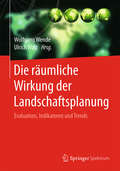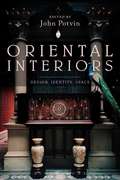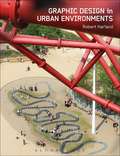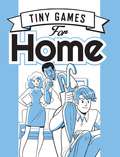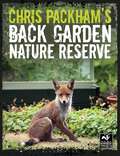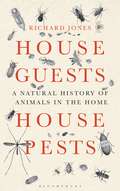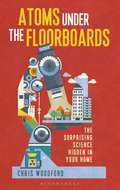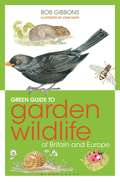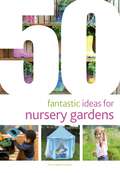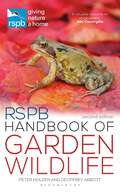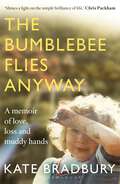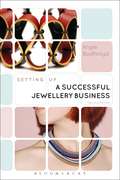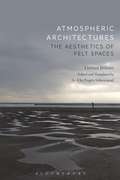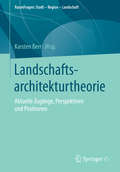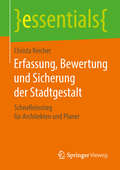- Table View
- List View
Domestic Interiors: Representing Homes from the Victorians to the Moderns
by Georgina DowneyIn the act of enclosing space and making rooms, we make and define our aspirations and identities.Taking a room by room approach, this fascinating volume explores how representations of domestic space have embodied changing spatial configurations and values, and considers how we see modern individuals in the process of making themselves 'at home'. Scholars from the US, UK and Australasia re-visit and re-think interiors by Bonnard, Matisse, Degas and Vuillard, as well as the great spaces of early modernity; the drawing room in Rossetti's house, hallways in Hampstead Garden Suburb, the Paris attic of the Brothers Goncourt; Schütte-Lihotzky's Frankfurt Kitchen, to explore how interior making has changed from the Victorian to the modern period.From the smallest room - the bathroom - to the spacious verandas of Singapore Deco, Domestic Interiors focuses on modern rooms 'imaged' and imagined, it builds a distinct body of knowledge around the interior, interiority, representation and modernity, and creates a rich resource for students and scholars in art, architecture and design history.
Made in Italy: Rethinking a Century of Italian Design
by Grace Lees-Maffei Kjetil FallanGoods made or designed in Italy enjoy a profile which far outstrips the country's modest manufacturing output. Italy's glorious design heritage and reputation for style and innovation has 'added value' to products made in Italy. Since 1945, Italian design has commanded an increasing amount of attention from design journalists, critics and consumers. But is Italian design a victim of its own celebrity? Made in Italy brings together leading design historians to explore this question, discussing both the history and significance of design from Italy and its international influence. Addressing a wide range of Italian design fields, including car design, graphic design, industrial and interior design and ceramics, well-known designers such as Alberto Rosselli and Ettore Sottsass, Jr. and iconic brands such as Olivetti, Vespa and Alessi, the book explores the historical, cultural and social influences that shaped Italian design, and how these iconic designs have contributed to the modern canon of Italian-inspired goods.
Flow: Interior, Landscape and Architecture in the Era of Liquid Modernity
by Penny Sparke Patricia Brown Patricia Lara-Betancourt Gini Lee Mark TaylorFlow combines cutting-edge scholarship with practitioner perspectives to address the concept of 'flow' and how it connects interiors, landscapes and buildings, expanding on traditional notions of architectural prominence. Contributors explore the transitional and intermediary relationships between inside/outside. Through a range of case studies, authors extend the notion of flow beyond the western industrialised world and embrace a wider geography while engaging with the specificity of climate and place. Accompanied by stunning colour illustration and photography, Flow brings together historical, theoretical and practice-based approaches to consider themes of nature, mobility, continuity and frames.
Design by IKEA: A Cultural History
by Sara KristofferssonSara Kristoffersson's compelling study provides the first sustained critical history of IKEA. Kristoffersson argues that the company's commercial success has been founded on a neat alignment of the brand with a particular image of Swedish national identity – one that is bound up with ideas of social democracy and egalitarianism - and its material expression in a pared-down, functional design aesthetic. Employing slogans such as "Design for everyone†? and "Democratic design†?, IKEA signals a rejection of the stuffy, the 'chintzy', and the traditional in both design practices and social structures.Drawing on original research in the IKEA company archive and interviews with IKEA personnel, Design by IKEA traces IKEA's symbolic connection to Sweden, through its design output and its promotional materials, to examine how the company both promoted and profited from the concept of Scandinavian Design.
Shadow-Makers: A Cultural History of Shadows in Architecture
by Stephen KiteThe making of shadows is an act as old as architecture itself. From the gloom of the medieval hearth through to the masterworks of modernism, shadows have been an essential yet neglected presence in architectural history.Shadow-Makers tells for the first time the history of shadows in architecture. It weaves together a rich narrative – combining close readings of significant buildings both ancient and modern with architectural theory and art history – to reveal the key places and moments where shadows shaped architecture in distinctive and dynamic ways. It shows how shadows are used as an architectural instrument of form, composition, and visual effect, while also exploring the deeper cultural context – tracing differing conceptions of their meaning and symbolism, whether as places of refuge, devotion, terror, occult practice, sublime experience or as metaphors of the unconscious.Within a chronological framework encompassing medieval, baroque, enlightenment, sublime, picturesque, and modernist movements, a wide range of topics are explored, from Hawksmoor's London churches, Japanese temple complexes and the shade-patterns of Islamic cities, to Ruskin in Venice and Aldo Rossi and Louis Kahn in the 20th century. This beautifully-illustrated study seeks to understand the work of these shadow-makers through their drawings, their writings, and through the masterpieces they built.
Die räumliche Wirkung der Landschaftsplanung: Evaluation, Indikatoren und Trends
by Wolfgang Wende Ulrich WalzDieses Buch befasst sich mit Leitfragen in der Landschaftsplanung. Aufgabe der Landschaftsplanung ist es, die im Bundesnaturschutzgesetz genannten Ziele des Naturschutzes und der Landschaftspflege in Deutschland umzusetzen. Derzeit erlebt die örtliche Landschaftsplanung eine Renaissance, da die Kommunen mit ihr unter anderem die Auswirkungen der Gewinnung erneuerbarer Energien und der Siedlungsentwicklung auf Natur und Landschaft mildern und steuern wollen. Doch wo genau steht die örtliche Landschaftsplanung in Deutschland heute eigentlich? Rund 75 % der Kommunen besitzen einen Landschaftsplan. Kann die Landschaftsplanung bereits Erfolge vorweisen? Wie war die bisherige Steuerungswirkung eines Landschaftsplans? Wo genau entfalten die Landschaftspläne auch tatsächlich räumliche Wirkung? Diese Leitfragen beschäftigt ein ausgewähltes Autorinnen- und Autorenteam der verschiedensten Forschungseinrichtungen in Deutschland. Sie evaluieren das Planungsinstrument, zeigen neueste Landschaftsindikatoren auf und analysieren Trends der Landschaftsentwicklung und -planung. Das Buch enthält eine Fülle von Abbildungen, Grafiken und Karten, die ebenfalls den Zustand und die Entwicklung von Landschaft in Deutschland dokumentieren.
Oriental Interiors: Design, Identity, Space
by John PotvinSince the publication of Edward Said's groundbreaking work Orientalism 35 years ago, numerous studies have explored the West's fraught and enduring fascination with the so-called Orient. Focusing their critical attention on the literary and pictorial arts, these studies have, to date, largely neglected the world of interior design. Oriental Interiors is the first book to fully explore the formation and perception of eastern-inspired interiors from an orientalist perspective. Orientalist spaces in the West have taken numerous forms since the 18th century to the present day, and the fifteen chapters in this collection reflect that diversity, dealing with subjects as varied and engaging as harems, Turkish baths on RMS Titanic, Parisian bachelor quarters, potted palms, and contemporary yoga studios. It explores how furnishings, surface treatments, ornament and music, for example, are deployed to enhance the exoticism and pleasures of oriental spaces, looking across a range of international locations. Organized into three parts, each introduced by the editor, the essays are grouped by theme to highlight critical paths into the intersections between orientalist studies, spatial theory, design studies, visual culture and gender studies, making this essential reading for students and researchers alike.
Graphic Design in Urban Environments
by Robert HarlandGraphic Design in Urban Environments introduces the idea of a category of designed graphic objects that significantly contribute to the functioning of urban systems. These elements, smaller than buildings, are generally understood by urban designers to comprise such phenomena as sculpture, clock towers, banners, signs, large screens, the portrayal of images on buildings through "smart screens,†? and other examples of what urban designers call "urban objects.†?The graphic object as it is defined here also refers to a range of familiar things invariably named in the literature as maps, street numbers, route signs, bus placards, signs, architectural communication, commercial vernacular, outdoor publicity, lettering, banners, screens, traffic and direction signs and street furniture. One can also add markings of a sports pitch, lighting, bollards, even red carpets or well dressings.By looking at the environment, and design and deconstructing form and context relationships, the defining properties and configurational patterns that make up graphic objects are shown in this book to link the smallest graphic detail (e.g. the number 16) to larger symbolic statements (e.g. the Empire State Building). From a professional design practice perspective, a cross section through type, typographic, graphic and urban design will provide a framework for considering the design transition between alphabets, writing systems, images (in the broadest sense) and environments.
Tiny Games for Home
by Hide Seek Paulina GanucheauDesigned to give the maximum amount of fun for the minimum amount of rule-reading, Tiny Games for Home will let you find the perfect game for whatever situation you're in. All you need is this book, and the stuff that's around you. (Friends optional) There are games to play with spoons and sofas and TVs and turnips and books and bottles. Games about words, games about celebrities, games about the things and the people and the places in your life. Games for TV commercial breaks, games for toast, and games for lying in bed. Whether you're feeling creative or competitive, silly or energetic, we've got you covered."It's like carrying around a collection of Victorian parlour games – except the Tiny Games take advantage of modern social settings and contexts. They're amusing, raucous and inventive†? - The Guardian
Chris Packham's Back Garden Nature Reserve (The Wildlife Trusts)
by Chris PackhamMany of Britain's plants and animals have come to rely upon gardens as an essential lifeline as their natural habitats come under increasing pressure from human activity and global warming. This comprehensive book explains the best ways to attract wildlife to gardens and encourage it to stay there. Written in a light-hearted yet passionate and authoritative style, the guide challenges popular notions of 'weeds' and 'pests' and invites gardeners to think again about the choices they make.Chris Packham's informative and lively text is complemented by attractive photographs and illustrations that will encourage an interest in the natural world on your doorstep, whether your 'garden' is a rural idyll or an urban window box. Chris argues that we have become so spellbound by 'nature's celebrities' – tigers, pandas and their ilk – that we are in danger of overlooking the most exciting species of all: those that we can touch, smell and observe in our own backyard.
House Guests, House Pests: A Natural History of Animals in the Home
by Richard JonesToday we live in snug, well-furnished houses surrounded by the trappings of a civilised life. But we are not alone – we suffer a constant stream of unwanted visitors. Our houses, our food, our belongings, our very existence are under constant attack from a host of invaders eager to take advantage of our shelter, our food stores and our tasty soft furnishings.From bats in the belfry to beetles in the cellar, moths in the wardrobe and mosquitoes in the bedroom, humans cannot escape the attentions of the animal kingdom. Nature may be red in tooth and claw, but when it's our blood the bedbugs are after, when it's our cereal bowl that's littered with mouse droppings, and when it's our favourite chair that collapses due to woodworm in the legs, it really brings it home the fact that we and our homes are part of nature too.This book represents a 21st century version of the classic Mediaeval bestiary. It poses questions such as where these animals came from, can we live with them, can we get rid of them, and should we? Written in Richard Jones's engaging style and with a funky-retro design, House Guests, House Pests will be a book to treasure.
Atoms Under the Floorboards: The Surprising Science Hidden in Your Home
by Chris WoodfordUsing the modern home as a springboard, Atoms under the Floorboards introduces the reader to the fascinating and surprising scientific explanations behind a variety of common (and often entertainingly mundane) household phenomena, from gurgling drains and squeaky floorboards to rubbery custard and shiny shoes. Packed with facts and fun, each chapter focuses on a feature in each of the areas and slowly unpicks the science behind it.* Is it better to build skyscrapers like wobbly jellies or stacks of biscuits? *Can you burn your house down with an electric drill? *How many atoms would you have to split to power a lightbulb? *How can a raincoat be waterproof and breathable at the same time? Atoms under the Floorboards answers all these questions, and hundreds more. You'll never look at your home the same way again ...
Pocket Guide to the Orchids of Britain and Ireland
by Simon HarrapThe orchid family is one of the largest plant families in the world, reaching its highest diversity in the tropics where their exotic and colourful flowers are often truly breathtaking. Britain and Ireland have just 52 species of wild orchid, some of which are rare or scarce, whilst others are surprisingly inconspicuous. Yet, whether large or small, all orchids share flamboyant flower structures and incredible beauty.This pocket guide allows the identification of all species of orchid in the British Isles. It has concise text highlighting ID criteria as well as notes on biology, habitat and conservation, along with stunning colour photographs and accurate range maps based on maps compiled by the Biological Record Centre. This book provides the perfect guide to these beautiful and evocative plants, and is a must for any field naturalist.
Green Guide to Garden Wildlife Of Britain And Europe (Green Guides)
by John Davis Bob GibbonsAimed at both the general reader and amateur naturalist, this guide offers information on observing and identifying 150 of the species most commonly encountered in gardens of Britain and Europe. Each species' habits, range and important characteristics are described, while colour paintings show each in detail. There are sections on and how to encourage wildlife into your garden and how to watch it. Sound advice on conservation issues is also offered. The book can be used as both a home reference and a pocket companion in the field.
RSPB Gardening for Wildlife: New edition (RSPB)
by Adrian ThomasThere is something uplifting about having butterflies in your flowerbeds, frogs in your water feature and birds in your bushes, and knowing they're there because of you. Rich in detail and accessible in style, Gardening for Wildlife is the crucial companion to novices and expert gardeners alike. Adrian Thomas dispels myths and offers new insights and ideas, helping everyone understand what to do so gardens, large or small, can become ideal homes for wildlife.Building on the success of the award-winning first edition, this expanded and updated edition reflects the latest research and developments in nature-friendly gardening.The book serves as an expert guide to the practical aspects of this rewarding pastime and educates readers about the ecological principles involved, while exploding commonly held misconceptions that often deter people from pursuing a kinder approach to gardening.Adrian Thomas provides a detailed guide to the many and varied species that can contribute to a natural and healthy garden. Practical sections help you create entire habitats, such as woodland and meadow gardens, in your garden. And the massively expanded catalogue of the top 500 best garden flowers, shrubs and trees for wildlife, now includes colour photos of every species.If you love wildlife and want to encourage more to visit your garden, this inspirational book will help you sow the seeds and reap the rewards.
Green Guide to Herbs Of Britain And Europe (Green Guides)
by Bob Press Christine Hart-DavisThis compact, easy-to-use pocket-size guide is aimed at both the general reader and the amateur naturalist. Presenting 150 of the best known and most commonly used herbs, this book can be used for both home reference and as a companion in the field. The extensive introduction contains helpful advice on growing, collecting, harvesting and storing herbs, as well as explaining how to use them safely. A section on the history of herbalism and a glossary are also included. Each species is described in detail with information on where it can be found along with its different uses, accompanied by a full colour illustration to aid identification in the field.
50 Fantastic Ideas for Nursery Gardens (50 Fantastic Ideas)
by June O'Sullivan Clodagh HalseThe outdoor environment is a rich, dynamic and natural space for promoting learning and development in children of all ages. Its value as an essential learning resource has been recognised by many government policies, including the Early Years Foundation Stage (EYFS), particularly within the principle of 'Enabling Environments'. In a survey of schools who had improved their grounds, 65% reported an improved attitude to learning, 73% an improvement in behaviour and 64% a reduction in bullying.50 Fantastic Ideas for Nursery Gardens is packed full of exciting activities, such as making a bird feeder and a garden treasure hunt, that have been tried and tested in the LEYF (London Early Years Foundation) nursery gardens with the children and nursery staff. These are designed to enrich children's skills and knowledge by broadening their horizons and opening up wider opportunities, extend language and contribute to deeper conversations about the great outdoors.
RSPB Handbook of Garden Wildlife: Second Edition (RSPB)
by Peter Holden Geoffrey AbbottThis friendly handbook is full of practical advice on attracting wildlife to your garden, and encouraging creatures to stick around, as well as expert tips on green gardening, seasonal planting and garden predators.Colour photographs illustrate hundreds of mammals, birds, insects, invertebrates, reptiles and amphibians, flowers, trees, shrubs and fungi, while the comprehensive text explains everything you need to cultivate a haven for nature.The new edition includes additional species as well as fully updated text describing the diverse wildlife that can be found in British gardens. Finally, a DIY chapter is packed with projects for your garden, from building bat boxes to digging your own pond.
The Bumblebee Flies Anyway: A year of gardening and (wild)life
by Kate Bradbury'Wonderfully intense and honest - a poignant manual of how to grow hope against the odds.' Chris Packham, TV presenter and author of Fingers in the Sparkle JarFinding herself in a new home in Brighton, Kate Bradbury sets about transforming her decked, barren backyard into a beautiful wildlife garden. She documents the unbuttoning of the earth and the rebirth of the garden, the rewilding of a tiny urban space. On her own she unscrews, saws and hammers the decking away, she clears the builders' rubble and rubbish beneath it, and she digs and enriches the soil, gradually planting it up with plants she knows will attract wildlife. She erects bird boxes and bee hotels, hangs feeders and grows nectar- and pollen-rich plants, and slowly brings life back to the garden.But while she's doing this Kate's neighbours continue to pave and deck their gardens locking them away, the wildlife she tries to save is further threatened, and she feels she's fighting an uphill battle. Is there any point in gardening for wildlife when everyone else is drowning the land in poison and cement? Sadly, events take Kate away from her garden, and she finds herself back home in Birmingham where she grew up, travelling the roads she used to race down on her bike in the eighties, thinking of the gardens and wildlife she loved, witnessing more land lost beneath paving stones. If the dead could return, what would they say about the land we have taken, the ancient routes we have carved up, the wildlife we have lost?
Green Wedge Urbanism: History, Theory and Contemporary Practice
by Fabiano Lemes OliveiraAs towns and cities worldwide deal with fast-increasing land pressures, while also trying to promote more sustainable, connected communities, the creation of green spaces within urban areas is receiving greater attention than ever before. At the same time, the value of the 'green belt' as the most prominent model of green space planning is being widely questioned, and an array of alternative models are being proposed. This book explores one of those alternative models – the 'green wedge', showing how this offers a successful model for integrating urban development and nature in existing and new towns and cities around the world. Green wedges, considered here as ducts of green space running from the countryside into the centre of a city or town, are not only making a comeback in urban planning, but they have a deeper history in the twentieth century than many expect – a history that provides valuable insight and lessons in the employment of networked green spaces in city design and regional planning today. Part history, and part contemporary argument, this book first examines the emergence and global diffusion of the green wedge in town planning in the late 19th and early 20th centuries, placing it in the broader historic context of debates and ideas for urban planning with nature, before going on to explore its use in contemporary urban practice. Examining their relation to green infrastructures, landscape ecology and landscape urbanism and their potential for sustainable cities, it highlights the continued relevance of a historic idea in an era of rapid climate change.
Setting Up a Successful Jewellery Business
by Angie BoothroydAn updated edition of the best-selling handbook, this all-encompassing guide for jewellery entrepreneurs of all levels covers key lessons for setting up, running and growing a jewellery business.From the college graduate looking to set up a workshop, to the established maker ready to expand their business, Setting up a Successful Jewellery Business equips creative jewellers with the essential knowledge and tools to operate a professional jewellery business.Encouraging individuals to define their business objectives and strategy for the future, the guide deals with topics including:· presenting your brand;· protecting your designs;· how much to charge for your work;· selling to shops, galleries and individuals;· creating your website and driving traffic to it;· managing your time and finances plus other essential business skills.Updated with two new chapters, an expanded section on social media and a revised appendix, this is an indispensable jeweller's companion that provides the resources to take your business forward.
Atmospheric Architectures: The Aesthetics of Felt Spaces
by Gernot Böhme Tina Engels-SchwarzpaulThere is fast-growing awareness of the role atmospheres play in architecture. Of equal interest to contemporary architectural practice as it is to aesthetic theory, this 'atmospheric turn' owes much to the work of the German philosopher Gernot Böhme. Atmospheric Architectures: The Aesthetics of Felt Spaces brings together Böhme's most seminal writings on the subject, through chapters selected from his classic books and articles, many of which have hitherto only been available in German. This is the only translated version authorised by Böhme himself, and is the first coherent collection deploying a consistent terminology. It is a work which will provide rich references and a theoretical framework for ongoing discussions about atmospheres and their relations to architectural and urban spaces. Combining philosophy with architecture, design, landscape design, scenography, music, art criticism, and visual arts, the essays together provide a key to the concepts that motivate the work of some of the best contemporary architects, artists, and theorists: from Peter Zumthor, Herzog & de Meuron and Juhani Pallasmaa to Olafur Eliasson and James Turrell. With a foreword by Professor Mark Dorrian (Forbes Chair in Architecture, Edinburgh College of Art) and an afterword by Professor David Leatherbarrow, (Chair of the Graduate Group in Architecture, University of Pennsylvania), the volume also includes a general introduction to the topic, including coverage of it history, development, areas of application and conceptual apparatus.
Landschaftsarchitekturtheorie: Aktuelle Zugänge, Perspektiven und Positionen (RaumFragen: Stadt – Region – Landschaft)
by Karsten BerrDie Beiträge dieses Bandes untersuchen den Sinn und Zweck der Praxis von Landschaftsarchitekten, die bei der Gestaltung einer bewohnbaren Welt eine bedeutsame Rolle spielen. Diese Praxis ist in lebensweltliche, kulturelle und soziale Rahmenbedingungen eingebunden. Theorie hat zum einen dieser soziokulturellen Eingebundenheit der Praxis Rechnung zu tragen. Theorie hat sich aber auch auf ihren wissenschaftstheoretischen Status innerhalb der Wissenschaften und Disziplinen zu beziehen, um eine unnötige praxisferne Verwissenschaftlichung zu vermeiden. Insofern reflektiert die Landschaftsarchitekturtheorie die Bedingungen ihres eigenen Gelingens wie auch die Bedingungen für gelingende Praxis. Die Beiträge dieses Bandes tragen zum besseren Verständnis von Praxis wie Theorie für die Praxis der Landschaftsarchitektur bei.Der HerausgeberDr. Karsten Berr ist an der Universität Vechta tätig.
House of Fashion: Haute Couture and the Modern Interior
by Jess BerrySince Charles Fredrick Worth established his luxurious Maison de Couture in 1858, the interior has played a crucial role in the display of fashion. House of Fashion provides a full historical account of the interplay between fashion and the modern interior, demonstrating how they continue to function as a site for performing modern, gendered identities for designers and their clientele alike. In doing so, it traces how designers including Poiret, Vionnet, Schiaparelli and Dior used commercial spaces and domestic interiors to enhance their credentials as connoisseurs of taste and style.Taking us from the early years of haute couture to the luxury fashion of the present day, Berry explores how the salon, the atelier and the boutique have allowed fashion to move beyond the aesthetics of dress, to embrace the visual seduction of the theatrical, artistic, and the exotic. From the Art Deco allure of Coco Chanel's Maison to the luminous spaces of contemporary flagship stores, House of Fashion sets out fashion's links with key figures in architecture and design, including Louis Süe, Robert Mallet-Stevens, Eileen Gray, and Jean-Michel Frank. Drawing on photographs, advertisements, paintings and illustrations, this interdisciplinary study examines how fashionable interiors have shaped our understanding of architecture, dress, and elegance.
Erfassung, Bewertung und Sicherung der Stadtgestalt: Schnelleinstieg für Architekten und Planer (essentials)
by Christa ReicherChrista Reicher gibt einen Überblick über die Inhalte der Stadtgestalt und wie diese im planerischen Kontext im Sinne der Stadtgestaltung beeinflusst werden können. Neben einer Begriffsdefinition werden die unterschiedlichen Dimensionen der Stadtgestalt anschaulich beschrieben. In den vergangenen Jahrzehnten haben sich verschiedene Städtebauer und Stadtforscher mit der Stadtgestalt auseinandergesetzt. Hierzu werden die wichtigsten Theorien vorgestellt sowie ein Einblick in Methoden zur Erfassung und Bewertung der Stadtgestalt gewährt.Die Autorin Christa Reicher ist seit 2002 Professorin und Leiterin des Fachgebiets Städtebau, Stadtgestaltung und Bauleitplanung an der Fakultät Raumplanung der Technischen Universität Dortmund und ist Gründerin eines Planungsbüros mit Sitz in Aachen.





